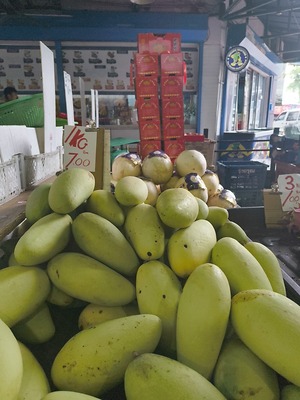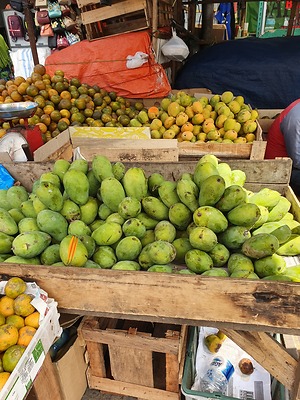


Brahm Kai Meu Mangoes
Estimated Inventory, ea : 0
Description/Taste
Brahm Kai Meu are a larger variety of mangoes that grow in clusters on the ends of long-stemmed trees. These oblong, egg-shaped fruits measure between 12 to 15 centimeters in length and 8 to 10 centimeters in width. Their color ranges from a light to a deeper green, dotted with small white speckles and occasionally marked by brown bruising. The skin is smooth yet slightly leathery, providing a protective layer over the juicy, bright yellow flesh inside, although it can make peeling somewhat challenging. The flesh itself is succulent, fiberless, and buttery. Inside, there is a large, thin seed that occupies a significant part of the fruit’s interior. Brahm Kai Meu mangoes emit a sweet, tropical fragrance with floral and fruity undertones. They are typically enjoyed when young and have a crunchy texture, featuring a delightfully sweet flavor that is reminiscent of candy and pure honey.
Seasons/Availability
Brahm Kai Meu mangoes are available from June to July.
Current Facts
The Brahm Kai Meu mango is a variety of Mangifera indica, the botanical name for the common mango, which belongs to the family Anacardiaceae. In Thailand, it is known locally as "Pram Kai Meu." Mangoes are incredibly popular in Thailand and are used in a diverse array of both sweet and savory dishes. Along with Brahm Kai Meu, several other mango varieties are cultivated across the country, including Nam Dok Mai, Khieo Sawoei Sampran, Ok Rhong Damnoen, Raed Paet, and Tong Dam. In Thailand, the peak season for mango cultivation is from March to June. During this season, vendors selling mangoes can be found in nearly every city and town—from Bangkok to Phuket, Chiang Mai to the islands along both the eastern and western coasts. Mangoes are celebrated throughout the year at various festivals, such as the Chiang Mai Mango Fair held in May. This event features a beauty contest to crown the ‘Mango Queen’, attracts local families for picnics, and, naturally, involves a lot of mango tasting.
Nutritional Value
Mangoes, including the Brahm Kai Meu variety, are rich in amylases—enzymes that help break down carbohydrates and facilitate digestion. These fruits are an excellent source of potassium, crucial for heart function and blood pressure regulation. They are high in vitamin C, which supports immune function and skin health, and provide a significant amount of vitamin B6, essential for brain development and maintaining a healthy nervous system. Mangoes are not only nutritious but also possess medicinal properties. Mango juice may serve as a restorative tonic and is used to treat heat stroke. Mango seeds are employed in traditional remedies for asthma and as an astringent. In Thailand, mangoes are made into various drinks to help reduce fever, alleviate stomach aches, and even cleanse wounds.
Applications
Brahm Kai Meu mangoes can be enjoyed either fresh or cooked. In Thailand, a popular way to savor these mangoes is with a dipping sauce. The two favorite sauces are ‘prik gleua,’ a mixture of salt, sugar, and dried chili, and ‘nam pla wan,’ a combination of chili, fish sauce, and palm sugar cooked to a caramel-like consistency. Brahm Kai Meu mangoes lend themselves well to ice cream, juices, and smoothies. When raw, they can be dried or pickled for preservation, incorporated into mango salsa, transformed into chutney or jam, added to salads, or used in curry sauces. Brahm Kai Meu mangoes can also be featured in desserts like cakes, tarts, and popsicles. They are best enjoyed before fully maturing and typically ripen at room temperature within four to six days.
Ethnic/Cultural Info
Mangoes hold a revered place in Hindu culture, often celebrated as the "King of Fruits." They symbolize prosperity, love, and fertility within Hinduism and are frequently used in religious rituals and festivals. It is estimated that there are between 400 and 1,000 different varieties of mangoes worldwide. The name "Brahm Kai Meu" mango is derived from a legend that suggests the fruit is so exceptionally delicious that a Brahmin—a member of the Hindu varna known for priests, teachers, and protectors of sacred learning—would trade his own wife for a taste of this mango.
Geography/History
Brahm Kai Meu mangoes are native to Thailand and thrive in tropical and subtropical climates. These mangoes aren’t commonly found in the wild and are predominantly cultivated in large-scale orchards and smaller farms that focus on fruit production. Mango cultivation dates back over 4,000 years, originating in the Indian subcontinent, specifically in regions now known as eastern India and Bangladesh. During the Spanish colonial period, mangoes were spread to other parts of the world, including the Philippines, Central and South America, Southeast Asia, and Africa. Although Brahm Kai Meu mangoes are mainly found in Thailand, they are also available in other tropical regions, including Australia and Florida. Outside of Thailand, these mangoes are typically sold in specialty Asian grocery stores or markets that specialize in exotic fruits. In climates conducive to their growth, Brahm Kai Meu mangoes can be cultivated in home gardens.
Recipe Ideas
Recipes that include Brahm Kai Meu Mangoes. One
| Shikigami |
|
Paneer and Raw Mango Curry |
| Rak's Kitchen |
|
Raw Mango Rice |
| Sailu's Kitchen |
|
Vankaya Mamidi Pachadi ~ Eggplant-Raw Mango Chutney |
Podcasts









